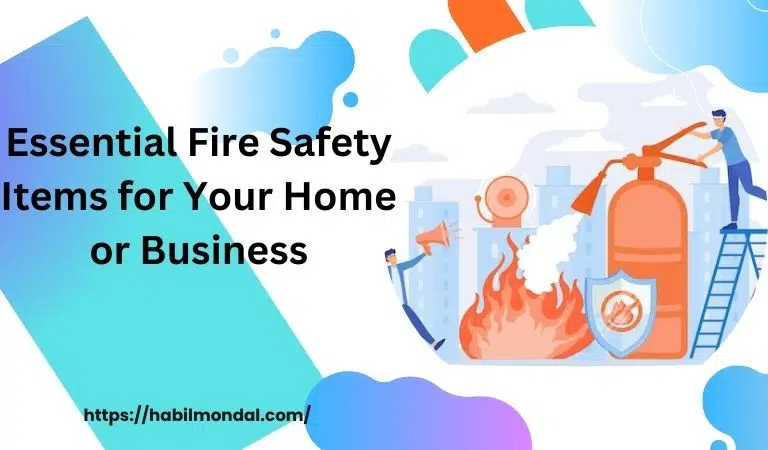In this article, we’ll take a look at some of the essential fire fighting equipment and their uses you should have in your home or business. From smoke detectors to fire extinguishers and more, we’ll cover everything you need to know to keep yourself and others safe.
Fire Safety Items list
Fire safety equipment is an essential tool that can help protect individuals and property from the destructive effects of fires. They come in different shapes and sizes and are designed to prevent, detect, or extinguish fires. So, below are some of the most common fire safety equipments and their functions:
- Smoke Detectors
- Fire Extinguishers
- Fire Blankets
- Emergency Ladders
- Escape Plans
- Carbon Monoxide Detectors
In summary, fire safety equipments are essential tools that can help prevent, detect, and extinguish fires. It’s important to have these items in your home or workplace, as they can help minimize the damage caused by fires and protect the safety of individuals.
So Remember to always use fire safety equipments properly and to seek professional advice if you are unsure about the type of item you need for your particular situation.
Smoke Detectors
Smoke detectors are devices that detect smoke and trigger an alarm. They can be battery-operated or hardwired into a building’s electrical system. Smoke detectors are also crucial for early fire detection, giving occupants time to evacuate the building before the fire becomes out of control.
- Install a smoke detector in every room of your home or business
- Test your smoke detectors monthly
- Replace batteries at least once a year
- Replace smoke detectors every 10 years
Types of Smoke Detectors
Smoke detectors are essential fire safety equipment for home that can help save lives by alerting people to the presence of smoke or fire in their homes or workplace.
There are two main types of smoke detectors: ionization and photoelectric. Each type operates differently and is better suited for detecting specific types of fires.
1. Ionization smoke detectors:
Ionization smoke detectors are the most common type of smoke detector as a Fire Safety Items . They use a small amount of radioactive material to ionize the air inside the detector.
When smoke enters the detector, it disrupts the ionization process and triggers the alarm. Ionization smoke detectors are more sensitive to fast-burning fires that produce small particles of smoke.
2. Photoelectric smoke detectors:
Photoelectric smoke detectors use a light source and a light-sensitive sensor to detect smoke. When smoke enters the detector, it scatters the light, which triggers the alarm.
Moreover, Photoelectric smoke detectors are more sensitive to slow-burning fires that produce larger particles of smoke. They are also less prone to false alarms caused by cooking or steam from a shower.
3. Combination smoke detectors:
Combination smoke detectors use both ionization and photoelectric technologies to detect smoke. They are considered the most effective type of smoke detector.
As they can detect both fast-burning and slow-burning fires. Combination smoke detectors are ideal for use in areas where multiple types of fires may occur, such as a kitchen or garage.
4. Smart smoke detectors:
Smart smoke detectors are connected to a home’s Wi-Fi network and can be controlled using a smartphone app. They can provide real-time notifications to homeowners and emergency services in the event of a fire. Smart smoke detectors can also provide alerts for low batteries or other issues, allowing homeowners to take action before an emergency occurs.
In summary, smoke detectors are essential fire safety devices that can help save lives. It’s important to choose the right type of smoke detector for your home or workplace, based on the type of fires that may occur.
Moreover, Combination smoke detectors and smart smoke detectors are becoming more popular, as they offer enhanced detection capabilities and additional features that can help improve fire safety.
Placement of Smoke Detectors
Proper placement of smoke detectors is essential for their effective operation and to maximize the early detection of a fire. Fire Safety Items can alert occupants to the presence of smoke or fire, providing valuable time to evacuate the building and call for emergency services.
building: Smoke detectors should be installed on every level of a home or building, including the basement and attic. This will ensure that smoke is detected no matter where the fire starts.
Install smoke detectors in bedrooms: Smoke detectors should be installed in every bedroom and outside each sleeping area. This will ensure that individuals are alerted to the presence of smoke or fire while they are sleeping.
Install smoke detectors in common areas: Smoke detectors should be installed in common areas such as living rooms, family rooms, and hallways. This will ensure that smoke is detected no matter where it is coming from.
Place smoke detectors on the ceiling: Smoke detectors should be placed on the ceiling, at least 4 inches away from the wall. This placement ensures that the smoke will rise and be detected by the detector as soon as possible.
Avoid placing smoke detectors near air vents: Smoke detectors should be placed away from air vents, as air blowing from the vents may delay the detection of smoke.
Place smoke detectors in the kitchen: Smoke detectors should be installed in the kitchen, but not too close to cooking appliances. Cooking fumes can trigger a false alarm, so smoke detectors in the kitchen should be placed away from cooking appliances.
Test smoke detectors regularly: Once smoke detectors are installed, they should be tested regularly to ensure that they are also functioning properly. It’s recommended to test smoke detectors at least once a month and replace batteries annually.
Testing and Maintenance
Testing and maintenance of fire safety items are crucial to ensure Regular testing and maintenance can help prevent false alarms, ensure the safety of building occupants, and reduce the risk of property damage.
- Smoke detectors: Smoke detectors should be tested monthly by pressing the test button. This will confirm that the alarm sounds and that the battery is functioning properly.
- Fire extinguishers: Fire extinguishers should be inspected monthly to ensure that they are in their proper location and are easily accessible. They should also be checked annually by a qualified technician to ensure that they are fully charged and in good working condition.
- Fire alarms: Fire alarms should be tested regularly to ensure that they are functioning properly. This should be done by a qualified technician who can check the wiring, the sensors, and the alarm sound. In addition, fire alarm batteries should be replaced annually to ensure that they are always charged.
- Sprinkler systems: Sprinkler systems should be inspected annually by a qualified technician to ensure that they are in good working condition.
- Emergency lighting: Emergency lighting should be tested monthly to ensure that it is functioning properly. This includes checking that the lights are on, that the batteries are charged, and that the bulbs are working.
- Evacuation plans: Evacuation plans should be reviewed and updated regularly to ensure that they are current and accurate. Building occupants should be trained on evacuation procedures and the location of the nearest exits.
- Fire doors: Fire doors should be checked regularly to ensure that they are in good working condition. This includes checking that they close properly, that the seals are intact, and that there are no obstructions.
Fire Extinguishers
Fire extinguishers are one of the most crucial fire safety items. They are designed to put out small fires before they can spread and cause significant damage.
Fire extinguishers contain different types of extinguishing agents, such as water, foam, carbon dioxide, and dry powder. It’s essential to have the right type of fire extinguisher for the type of fire that may occur in your home or workplace.
- Keep a fire extinguisher on every floor of your home or business
- Choose the right type of fire extinguisher for the type of fire you may encounter
- Learn how to use a fire extinguisher before an emergency occurs
In summary, regular testing and maintenance of fire safety equipments are essential to ensure their reliable operation in the event of a fire.
Moreover, Building owners and managers should work with qualified technicians to ensure that all fire safety items are in good working condition and meet local safety codes and standards. By doing so, they can help protect building occupants and minimize the risk of property damage in the event of a fire.
Types of Fire Extinguishers
Fire extinguishers are an essential fire safety item that can use to quickly extinguish small fires. Before they become larger and more dangerous. There are several different types of fire extinguishers, each designed for different types of fires. The following are the most common types of fire extinguishers:
1. Class A extinguishers:
Class A extinguishers are designed to extinguish fires involving ordinary combustibles, such as wood, paper, cloth, and plastics. These types of fires are typically found in homes, offices, and also schools.
2. Class B extinguishers:
Class B extinguishers are designed to extinguish fires involving flammable liquids and gases. Such as gasoline, oil, propane, and natural gas. These types of fires are typically found in industrial settings and garages.
3. C extinguishers:
Class C extinguishers are designed to extinguish fires involving electrical equipment, such as computers, appliances, and wiring. These extinguishers are non-conductive, which means they can be safely used on electrical fires without the risk of shock.
4. Class D extinguishers:
Class D extinguishers are designed to extinguish fires involving flammable metals, such as magnesium, titanium, and sodium. These types of fires are typically found in manufacturing and laboratory settings.
5. Class K extinguishers:
Class K extinguishers are designed to extinguish fires involving cooking oils and fats, which are commonly found in commercial kitchens. These extinguishers use a wet chemical agent that helps to cool the fire and prevent re-ignition.
6. Multi-purpose extinguishers:
Multi-purpose extinguishers are designed to handle multiple classes of fires, such as Class A, B, and C fires. These extinguishers are a good choice for homes and small businesses, where the risk of multiple types of fires is present.
Overall, It’s important to select the appropriate type of fire extinguisher for the potential fire hazards in your home or workplace.
How to Use a Fire Extinguisher
Knowing how to use a fire extinguisher is an important part of fire safety. Here is a step-by-step guide on how to use a fire extinguisher:
Assess the situation: Before using a fire extinguisher, make sure the fire is small enough to be safely extinguished with an extinguisher. If the fire is too large or out of control, evacuate the building immediately and call the fire department.
Identify the type of fire: It’s important to use the correct type of fire extinguisher for the type of fire safety items you are trying to extinguish. Refer to the label on the fire extinguisher to determine the type of fire it is designed for.
Position yourself and the extinguisher: Stand approximately 6-8 feet away from the fire and keep the fire extinguisher upright. Make sure you have a clear escape route behind you.
Pull the pin: Pull the pin at the top of the fire extinguisher. This will break the seal and allow you to discharge the extinguisher.
Aim at the base of the fire: Aim the nozzle at the base of the fire, not the flames. This is where the fuel source is located and where the fire is being fueled.
Squeeze the handle: Squeeze the handle to discharge the extinguisher. Use a sweeping motion to cover the entire area of the fire.
Continue to monitor the fire: After using the fire extinguisher, continue to monitor the fire to make sure it doesn’t reignite. If it does, use the fire extinguisher again or evacuate the building.
Evacuate the building: If the fire cannot be safely extinguished, evacuate the building immediately and call the fire department.
Placement of Fire Extinguishers
Proper placement of fire extinguishers is crucial for effective fire protection. Here are some guidelines for the placement of fire extinguishers:
- Place extinguishers in easily accessible locations: Fire extinguishers should be placed in easily accessible locations, such as hallways, near exits, and in areas where fires are most likely to occur, such as kitchens and workshops.
- Mount extinguishers at the correct height: Fire extinguishers should be mounted at a height that is easily reachable and visible. Typically, fire extinguishers are mounted between 3-5 feet above the ground.
- Keep extinguishers visible and unobstructed: Fire extinguishers should visible and unobstructed so that they can be easily located in an emergency. Make sure that furniture, equipment, or other objects do not block or hide the extinguishers.
- Place extinguishers near potential fire hazards: Extinguishers should place them near potential fire hazards, such as stoves, ovens, electrical equipment, and flammable liquids. This will help to reduce response time in the event of a fire.
- Consider the size of the extinguisher: Different areas may require different sizes of extinguishers. For example, a large workshop or warehouse may require larger extinguishers than a small office or home.
- Use signage to indicate the location of extinguishers: Signage can use to indicate the location of fire extinguishers, making them easier to locate in an emergency. Signs should be placed at eye level and clearly visible.
Fire Blankets
Fire blankets are made of fire-resistant materials and can use to smother small fires. They are typically made of fiberglass or other materials that can withstand high temperatures. Fire blankets are ideal for extinguishing small kitchen fires, as they can wrap around a person to help extinguish any flames on their clothes.
- Use a fire blanket to smother small fires or wrap around a person on fire
- Make sure your fire blanket made from fire-resistant materials
In summary, fire safety items are essential tools that can help prevent, detect, and extinguish fires. It’s important to have these items in your home or workplace. As they can help minimize the damage caused by fires and protect the safety of individuals.
Remember to always use fire safety equipment properly. And to seek professional advice if you are unsure about the type of item you need for your particular situation.
Uses of Fire Blankets
Fire blankets are a type of fire safety equipment that can use to extinguish small fires or to protect people from flames and heat. They make of flame-resistant materials and can also use in a variety of settings. Here are some common uses of fire blankets:
- Kitchen fires: Fire blankets can use to extinguish small fires in the kitchen, such as grease fires, by smothering the flames. They can also use to wrap around a person whose clothing has caught fire.
- Electrical fires: Fire blankets can use to extinguish electrical fires by smothering the flames and cutting off the oxygen supply.
- Car fires: Fire blankets can use to put out small fires in a car, or to protect occupants from the flames. Heat while they evacuate the vehicle.
- Welding fires: Fire blankets can use to protect workers from welding fires by wrapping the blanket around them.
- Laboratory fires: Fire blankets can use to put out small fires in laboratories or to protect workers from flames and heat.
- Industrial fires: Fire blankets can use in industrial settings to smother small fires or to protect workers from flames and heat.
Moreover, Fire blankets are easy to use and can be quickly deployed in an emergency. They are also reusable, provided they have not been damaged in use.
Overall, It’s important to note that fire blankets should only be used on small fires and not on large or out-of-control fires. If a fire is too large to be extinguished with a fire blanket. Evacuate the area immediately and call the fire department.
How to Use a Fire Blanket
Using a fire blanket is a simple process, but it’s important to know the correct steps to ensure safety. Here’s how to use a fire blanket as a fire safety items:
- Retrieve the fire blanket: If you are in a location with a fire blanket, retrieve it as quickly as possible. If you have to go to another location to get it, make sure you do so safely and quickly.
- Protect yourself: Before approaching the fire, protect yourself by putting on gloves and closing any doors or windows in the area to contain the fire.
- Cover the fire: Approach the fire blanket slowly and carefully, holding it by the corners to avoid getting burned. Place the blanket over the fire, making sure it completely covers the flames. Do not lift the blanket once it is in place, as this can reignite the fire.
- Turn off the heat source: If the fire is caused by a heat source, such as a stove or oven, turn it off before using the fire blanket.
- Leave the blanket in place: Once the fire is covered, leave the fire blanket in place until it cools down. This will help ensure that the fire is completely extinguished.
- Evacuate the area: After the fire is out, evacuate the area and call the fire department if necessary. Do not attempt to move the blanket until it has cooled down completely.
Overall, it’s important to remember that fire blankets are only effective for small fires. If a fire is too large or out of control, evacuate the area immediately and call the fire department.
Additionally, fire blankets should be inspected and maintained regularly to ensure that they are in good working condition and ready for use in an emergency.
Emergency Ladders Fire Safety Items
Emergency ladders are a type of fire safety equipments that can be used to evacuate a building in the event of a fire or other emergency.
Moreover, they are designed to be portable and easy to use, and they can be deployed quickly to provide a safe exit for people who are unable to use the building’s regular exits.
- Types of emergency ladders: There are two main types of emergency ladders: permanent and portable. Permanent emergency ladders are installed on the outside of a building and can be used for quick and easy evacuation in the event of an emergency. Portable emergency ladders are typically made of lightweight materials and can be easily transported from one location to another.
- How to use an emergency ladder: To use an emergency ladder, place it securely against a window or other opening that provides a safe exit. Secure the ladder in place by hooking the top rung over the window sill or other support. Then, climb down the ladder one rung at a time, facing the ladder and keeping your body close to it. Use your arms to support your weight and maintain a secure grip on the ladder.
- Benefits of emergency ladders: Emergency ladders provide a safe and easy exit from a building in the event of an emergency. They can be especially helpful for people who are unable to use the building’s regular exits, such as those with mobility issues or those who are located on upper floors.
In summary, emergency ladders are an important part of fire safety equipment that can provide a safe exit from a building in the event of an emergency. They are easy to use and deployed quickly to help ensure the safety of those inside the building.
Escape Plans Fire Safety Items
Having an escape plan in place is an essential part of Fire Safety Item. Knowing what to do in the event of a fire can help you and your family evacuate quickly and safely. Here are some steps to create an effective escape plan:
- Identify potential escape routes: Look for all the possible ways out of your home or building. This may include doors, windows, and other exits.
- Draw a floor plan: Draw a floor plan of your home or building and mark all the possible escape routes. So, make sure that all members of your household are aware of these routes and can identify them easily.
- Establish a meeting place: Choose a safe place outside your home or building where everyone can meet after they evacuate. This can be a neighbor’s house, a street corner, or any other location that is a safe distance from the building.
- Practice your escape plan: Conduct regular fire drills to practice your escape plan. Make sure that everyone in your household knows what to do in the event of a fire, and practice using all of the escape routes.
- Make sure everyone is aware of the plan: Once you have created your escape plan, make sure that everyone in your household is aware of it. Review the plan regularly to ensure that everyone remembers what to do in the event of a fire.
Overall, Remember that having a well-thought-out escape plan in place can be a lifesaver in the event of a fire. By identifying potential escape routes, practicing your plan regularly, and making sure that everyone in your household is aware of the plan
Carbon Monoxide Detectors Fire Safety Items
Carbon monoxide (CO) detectors are an essential part of fire safety equipment, as they can detect the presence of carbon monoxide gas, which is a colorless, odorless gas that is extremely toxic. Here are some important things to know about Fire Safety equipments carbon monoxide detectors:
- How they work: Carbon monoxide detectors work by detecting the levels of carbon monoxide in the air. When the levels of carbon monoxide reach a dangerous level, the detector will emit a loud alarm to alert people in the area to evacuate.
- Placement: Carbon monoxide detectors should be placed in areas where there is a risk of carbon monoxide exposure, such as near fuel-burning appliances, fireplaces, and gas water heaters. They should also be placed outside of each sleeping area in the home, as carbon monoxide can be especially dangerous when people are sleeping.
- Testing and maintenance: Carbon monoxide detectors should be tested regularly to ensure that they are working properly. This can be done by pressing the test button on the detector. In addition, the batteries in the detector should be replaced regularly, and the detector itself should be replaced every 5-7 years.
- Benefits: Carbon monoxide detectors are an essential part of fire safety equipment, as they can detect the presence of carbon monoxide gas, which is extremely toxic. By alerting people to the presence of this gas, they can help to prevent serious illness or death from carbon monoxide poisoning.
In summary, carbon monoxide detectors are an essential part of fire safety equipment. By detecting the presence of carbon monoxide gas, they can help to prevent serious illness or death from carbon monoxide poisoning.
Moreover, By placing them in the appropriate locations, testing and maintaining them regularly, and being aware of their benefits.
FAQs:
1. Q: How many smoke detectors do I need?
A: You should have at least one smoke detector in every room of your home or business.
2. Q: What type of fire extinguisher should I use for a grease fire?
A: Use a Class K fire extinguisher, designed specifically for the kitchen.
READ RELATED CONTENT:
Bangladeshi Startups: Entrepreneurial Scene in Bangladesh
Conclusion
Fire safety items is an important aspect of ensuring the safety of ourselves and our loved ones. It involves being prepared and having the appropriate equipment and knowledge to prevent and respond to fires.
Smoke detectors, fire extinguishers, fire blankets, emergency ladders, and carbon monoxide detectors are all essential items that can help prevent fires and save lives in the event of an emergency.
By understanding how to properly use and maintain these items, and by creating an effective escape plan, we can help to ensure the safety of ourselves and our communities. Remember, it is better to be prepared and never have a fire than to be unprepared and face a devastating loss.







